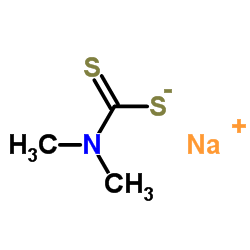Ferbam iron salt

Ferbam iron salt structure
|
Common Name | Ferbam iron salt | ||
|---|---|---|---|---|
| CAS Number | 14484-64-1 | Molecular Weight | 422.54 | |
| Density | N/A | Boiling Point | 129.4ºC at 760mmHg | |
| Molecular Formula | C9H24FeN3S6 | Melting Point | 180°C (dec.) | |
| MSDS | Chinese USA | Flash Point | 32ºC | |
| Symbol |


GHS07, GHS09 |
Signal Word | Warning | |
Use of Ferbam iron saltFerbam (Iron(III) dimethyldithiocarbamate) is a potent fungicide[1]. |
| Name | ferbam |
|---|---|
| Synonym | More Synonyms |
| Description | Ferbam (Iron(III) dimethyldithiocarbamate) is a potent fungicide[1]. |
|---|---|
| Related Catalog | |
| References |
| Boiling Point | 129.4ºC at 760mmHg |
|---|---|
| Melting Point | 180°C (dec.) |
| Molecular Formula | C9H24FeN3S6 |
| Molecular Weight | 422.54 |
| Flash Point | 32ºC |
| Exact Mass | 415.917450 |
| PSA | 181.89000 |
| LogP | 3.08870 |
| Stability | Stable. Incompatible with strong oxidants. |
CHEMICAL IDENTIFICATION
HEALTH HAZARD DATAACUTE TOXICITY DATA
MUTATION DATA
|
| Symbol |


GHS07, GHS09 |
|---|---|
| Signal Word | Warning |
| Hazard Statements | H315-H319-H335-H410 |
| Precautionary Statements | P261-P273-P305 + P351 + P338-P501 |
| Personal Protective Equipment | dust mask type N95 (US);Eyeshields;Gloves |
| Hazard Codes | Xi: Irritant;N: Dangerous for the environment; |
| Risk Phrases | R36/37/38;R50/53 |
| Safety Phrases | 26-36/37/39-61-60 |
| RIDADR | UN3077 9/PG 3 |
| WGK Germany | 3 |
| RTECS | NO8750000 |
| Hazard Class | 3,6.1 |
| HS Code | 2930200012 |
|
~% 
Ferbam iron salt CAS#:14484-64-1 |
| Literature: Comptes Rendus Hebdomadaires des Seances de l'Academie des Sciences, , vol. 146, p. 982 Bulletin de la Societe Chimique de France, , vol. <4>3, p. 650 Bulletin de la Societe Chimique de France, , vol. 3, p. 643 - 643 Comptes Rendus Hebdomadaires des Seances de l'Academie des Sciences, , vol. 144, p. 1125 - 1125 Fe: MVol.B3, 2, page 515 - 518 |
| Precursor 2 | |
|---|---|
| DownStream 0 | |
| HS Code | 2930200012 |
|---|---|
| Summary | 2930200012 iron(iii) dimethylcarbamodithioate。supervision conditions:s(import or export registration certificate for pesticides)。VAT:17.0%。tax rebate rate:9.0%。MFN tarrif:6.5%。general tariff:30.0% |
|
A new 2D-TLC bioautography method for the discovery of novel antifungal agents To control plant pathogens.
J. Nat. Prod. 63(8) , 1050-4, (2000) A new bioassay has been developed combining the simplicity of direct bioautography with the improved chromatographic resolution of 2D-TLC. Mixtures of structurally diverse antifungal agents were teste... |
|
|
Spectrophotometric determination of ferbam (iron(III) dimethyldithiocarbamate) in commercial sample and wheat grains using 4,7-diphenyl-1,10-phenanthroline after extraction into mesityl oxide.
J. Environ. Monit. 2(2) , 151-3, (2000) A procedure has been developed for the determination of iron(III) dimethyldithiocarbamate by converting it into iron(II)-bathophenanthroline complex, which is then extracted into mesityl oxide in the ... |
|
|
Spectrophotometric determination of ferbam [iron(III) dimethyl dithiocarbamate] in commercial sample and wheat grains after extraction of its bathophenanthroline tetraphenylborate complex into molten naphthalene.
J. Agric. Food Chem. 48(9) , 4044-7, (2000) A procedure has been developed for the determination of iron(III) dimethyldithiocarbamate by converting it into a iron(III)-bathophenanthroline-tetraphenylborate complex, which was then extracted into... |
| Tris(diméthyldithiocarbamate) de fer(3+) |
| MFCD00067269 |
| Aaferzimag |
| N,N-dimethylcarbamodithioate,iron(3+) |
| tris(dimethyldithiocarbamato)iron(III) |
| Carbamodithioic acid, N,N-dimethyl-, iron(3+) salt (3:1) |
| tris(N,N-dimethyldithiocarbamato)iron(III) |
| dimethyl-dithiocarbamic acid,iron (III)-compound |
| Ferbam |
| Ferberk |
| Dimethyl-dithiocarbamidsaeure,Eisen(III)-Verbindung |
| Cormate |
| iron(3+) dimethyldithiocarbamate |
| Dimethyldithiocarbamic Acid Ferric Salt |
| Eisen(3+)tris(dimethyldithiocarbamat) |
| Iron(3+) tris(dimethylcarbamodithioate) |
| Fermacide |
| Aafertis |
| Iron(III) dimethyldithiocarbamate |
| Trimanzone |
| EINECS 238-484-2 |
| (OC-6-11)-tris(dimethylcarbamodithioato-κS,κS’)iron |
| ferric dimethyldithiocarbamate |
| Ferbam iron salt |



